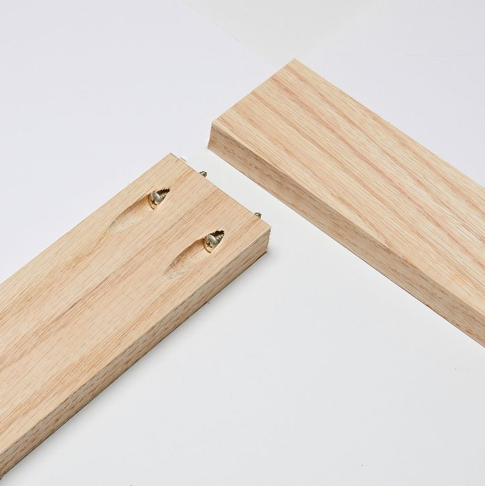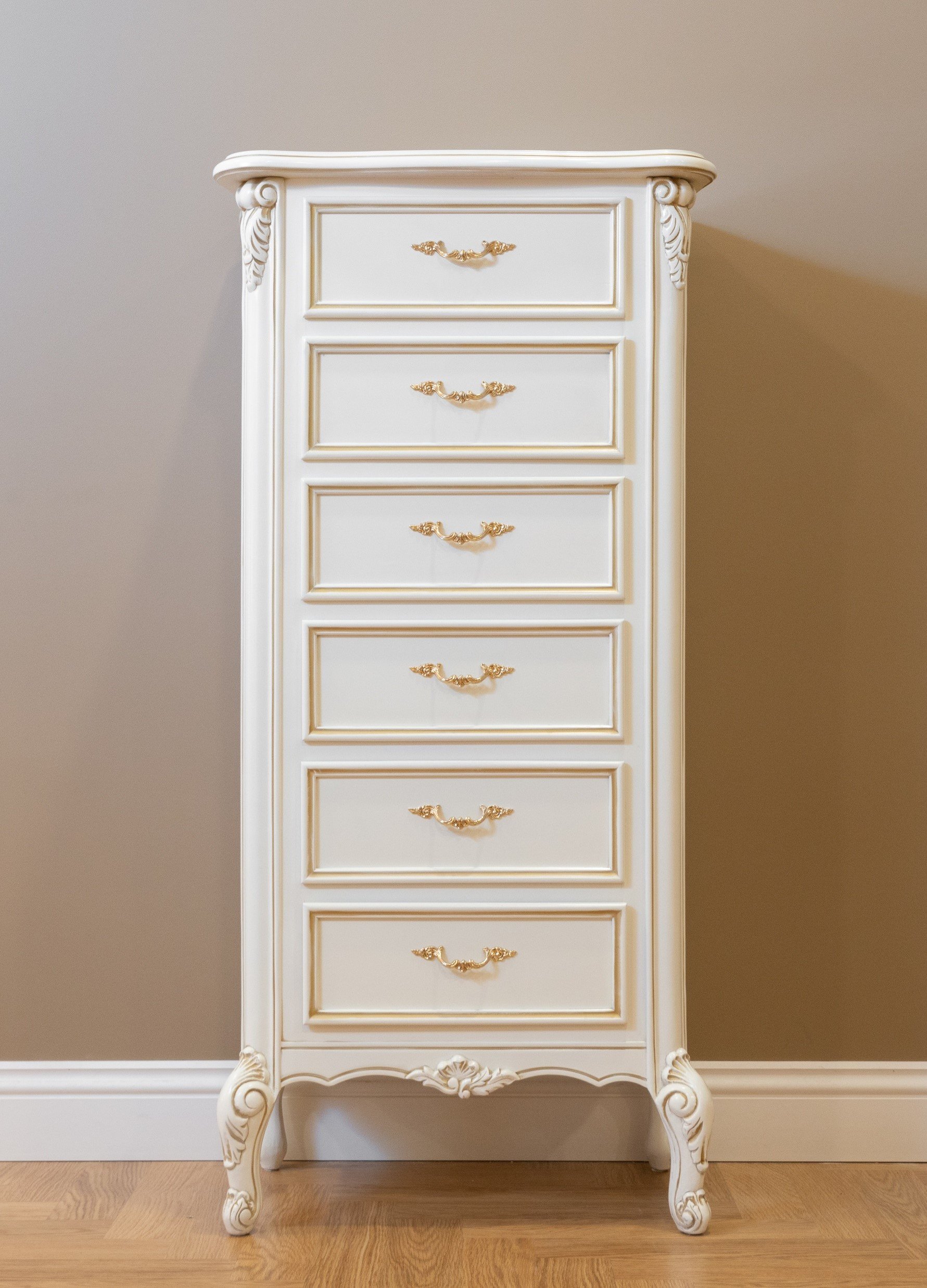The quality of your wood furniture can make or break the overall look and feel of your home.
High-quality wood furniture, or casegoods – as they’re also referred to, can last a lifetime or more generations.
Wood pieces, in every shape and finish, have been around since people started living indoors, and their durability and natural beauty have a timeless appeal.
However, not all pieces of wood furniture are timeless. Some, in fact, don’t even pass the “real wood furniture” criteria at all…
Whether you're in the market for a new dresser, bookshelf, or coffee table, it's important to know how to spot good quality pieces. Ultimately, this will help you make solid buying decisions so you can be confident your investment lasts a long time - maybe even those multiple generations!
In this post, I'll tell you how to spot high-quality wood furniture, including how to examine the joints, drawers, finish, and legs. And, by the end, you'll be able to confidently spot those great pieces that make your home look elevated and affluent!
Casegoods:
1. Check the Joints:
Joints are the areas where two pieces of wood come together to form a corner or an edge, and they’re critical for the overall stability and durability of the piece.
One important thing to look for is whether the joints are glued or screwed.
Glue is a strong adhesive that can create a durable bond between two pieces of wood, and it is often used in furniture construction to reinforce joints. No, this is not the Elmer’s glue from grade school, this is a super strong adhesive that creates a permanent bond between joints.
The Family Handyman
Screws are often also used to secure joints, but they can be more prone to loosening over time, which can compromise the stability of the piece. That doesn’t mean the piece is low quality, it just means that a little tightening is needed to make your piece sturdy.
The Family Handyman
That said, many top furniture manufacturers will use a combination of glue and screws to get the tightest and best construction.
Here’s some common joints to look for:
Dowel joints: This involves drilling holes in one piece of wood and inserting dowels into those holes, which are then glued into place to secure the joint. You’ll find these types of joints in many shelves, etageres, and some cabinetry and tables. If you can’t see how pieces are joined together, but they still feel very secure, it’s probably a dowel joinery.
Mortise and tenon joints: This is where a hole in one piece of wood is designed to fit a protruding piece of wood from the other piece, which is then glued together. You’ll find these in many types of furniture, especially cabinetwork.
This type of joinery can often be visible adding to the decoration of a piece. The mortise often goes all the way through the wood, which allows the tenon to be visible, it’s also a very solid joint that isn’t affected by wood expansion and contraction.
Dovetail joints: Have cut, interlocking shapes in the wood that fit together tightly to create a strong, durable joint. You’ll find this type of joinery in many drawers for dressers, credenzas, and end tables.
One of the first things I learned in my furniture selling career was the importance of dove tail joinery – specifically in drawers. Dove tails provide an almost indestructible joint construction.
The “pitch” I was trained to use was imagine all the objects you might place inside a drawer. The weight from those objects, coupled with pulling the drawer open thousands of times could result in the drawer breaking if the front was attached with a lesser construction, like a rabbet joint. (This is what you’ll usually find in mass produced, lower quality casegoods. These joints are secured with staples. When you pull on that drawer thousands of times, no matter the weight inside the drawer, you’re going to pull it off eventually.)
The quality of dovetail joints is evident at first glance and the pitch story usually sealed the deal. It was never about luxuriating in the features of the drawer, it was always about educating on the quality of the piece.
In addition to checking the type of joint, it's also important to look at the overall construction of the piece.
Charlotte May
Look for signs of quality craftsmanship, like smooth and even surfaces, tight-fitting joints, and clean edges.
Any gaps or unevenness in the joints can be a sign of poor-quality construction and can lead to instability and damage over time.
2. Look at the Drawers:
Drawers are a key feature of many types of casegoods, like dressers, nightstands, and desks, and they play an important role in the overall functionality of the piece.
Cup of Couple
It’s important to look at the drawer itself. The drawer box should be made of a sturdy material, such as solid wood, and shouldn’t have any cracks, warping, or other signs of damage.
The bottom of the drawer should be secured to the sides and back with dado joints, which are grooves cut into the wood to create a secure and durable joint.
The drawer should also slide smoothly and quietly in and out of the piece, with minimal wobbling or rattling.
Look at the hardware used in the construction the drawer.
High-quality hardware, like metal glides or ball-bearing slides, will support the weight of the drawer and allow it to slide in and out smoothly.
The drawer pulls should also be secure and well-attached, with no signs of wobbling or loosening.
Notice the appearance of the drawers.
Max Rahubovskiy
The finish should be smooth and even, with no signs of cracks or peeling. If the drawer fronts are painted or stained, the color should be consistent and even across the entire surface.
3. Examine the Finish:
Speaking of the finish, here’s more specifics on what to look for:
The finish is the final step in the construction of wood furniture, and it has a big impact on the overall appearance, durability, and longevity of the piece.
As you inspect the finish, the first thing to look for is consistency.
The color should be even across the entire piece, with no visible brush marks or inconsistencies.
If the piece is stained, the color should be consistent across all parts, and there should be no visible blotches or streaks.
Notice the level of sheen in the finish.
The level of sheen, or gloss, can vary depending on the look and style of the piece. However, regardless of the level of sheen, the finish should be smooth, without any bumps, bubbles, or other imperfections.
Pay attention to the durability of the finish too.
Mendy Van Hoogdalem van Barneveld
A high-quality finish will be resistant to scratches, dings, and other forms of wear and tear that can occur over time. If the finish is easily scratched or marred, it may be a sign of poor-quality construction or low-quality materials.
Check for any signs of damage or wear on the finish.
Look for areas where the finish may be chipped, cracked, or peeling. These can also be signs of poor-quality or damage that has occurred during shipping or handling.
4. Check the Legs:
The legs play a big role in the stability and weight-bearing capacity of casegoods, like dressers, cabinets, and tables.
Vlada Karpovich
Check the material they’re made of.
The legs should be made of sturdy and durable materials: solid wood or metal, and they should also be thick enough to support the weight of the piece without bending or buckling.
How they’re attached is also important.
The legs should be securely attached to the base of the piece, with no signs of wobbling or instability. If the legs are attached with screws or bolts, make sure they are tight and secure.
Consider the consistency of design between the legs and the casegood.
The legs should complement the design and style of the piece and should not look mismatched or out of place.
For example, a modern sideboard may look best with sleek metal legs, while a traditional wooden dresser may look best with wooden legs that have decorative carvings that add visual interest.
Ono Kosuki
Tip: Take a measuring tape with you when you’re out shopping for casegoods. This will come in handy if the dimensions of the piece are not displayed. This is important to know the length, width, and height of a piece for an accurate fit when you get it home. There’s nothing worse than finding the perfect piece and not being able to get it in the house or have it fit where you need it to be, right?
So, when it comes to buying wood furniture, it's best to invest in pieces that are well-made and built to last.
Knowing how to spot good quality wood furniture can help you make better decisions about your purchases, so you get the most value for your money.
By examining the joints, drawers, finish, and legs, you’ll be able to spot the craftsmanship and durability.
Also, think about the type of wood used and the manufacturing process to determine the overall quality of the piece.
Here’s a chart to recognize common wood grain patterns in high-quality furniture.
Michael Helwig Interiors
With these tips in mind, you'll be able to find beautiful, functional wood furniture that will bring warmth and style to your home for years to come. Remember to prioritize quality over price, as investing in high-quality wood furniture is a smart choice that will pay off in the long run.
Read Next
The Ultimate Guide To Spotting High-Quality Upholstery: Tips And Tricks
Learn how to spot good quality upholstered furniture by evaluating key features such as the frame, springs, cushions, fabric, and construction details. With the right knowledge, you can make an informed decision and find a beautiful and well-made piece of furniture that will provide both comfort and durability for years to come.
Join the Fun!
If you enjoyed this post and you want to keep seeing my weekly blog, the best way to do that is to subscribe.
You can subscribe by downloading my 11 Secrets Only Designers Know to Make Your Space Rock. If you’re curious about how decorators and designers make a home look magazine ready, you’ll love taking a gander at these 11 secrets. You’ll learn how to style your room from the floor up and it will work for ANY space you have.
I write about small space design and decorating, sustainable furniture options, positive self care and a variety of do-it-yourself home décor.
I’d love to connect with you!
“Michael Helwig was top-notch, very professional and responsive to my needs. He allowed me time to explore ideas and try out a variety of combinations until we found the perfect fit. Michael provided detailed information and offered beautiful ideas to make my dream living room become a reality. The furniture he sourced has totally transformed my living room space. Everyone that has seen my new living room has one word, WOW! A special thank you to Michael for a wonderful experience.”
“Michael was very knowledgeable and guided us, with great patience and good humor, through the process of designing our dining room and helping us find the perfect sleeper sofa. He offered really helpful advice when we asked questions - which was often - but at no time did we ever feel pushed. He helped me when I felt like I couldn’t make one more decision. When my new furniture finally arrived I realized everything down to the pillows was perfect. I couldn’t be happier!”
Ekrulila
Michael is Principal designer and blogger at Michael Helwig Interiors in beautiful Buffalo, New York. Since 2011, he’s a space planning expert, offering online interior e-design services for folks living in small homes, or for those with awkward and tricky layouts. He’s a frequent expert contributor to many National media publications and news outlets on topics related to decorating, interior design, diy projects, and more. Michael happily shares his experience to help folks avoid expensive mistakes and decorating disappointments. You can follow him on Pinterest, Instagram and Facebook @interiorsmh.



























